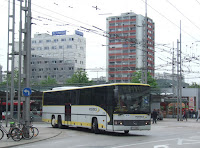(Updated May 2013)
The Austrian city of Salzburg is firmly established on the European tourist trail. It is famous as the birthplace of Mozart and was also the setting for The Sound of Music.
The city is dominated by a castle, the Festung Hohensalzburg, which overlooks the city from its perch on Mönchsberg.
The city is dominated by a castle, the Festung Hohensalzburg, which overlooks the city from its perch on Mönchsberg.
 A funicular railway climbs from the historic city centre to the castle.
A funicular railway climbs from the historic city centre to the castle. 
 The streets at the historical heart of Salzburg are narrow and partially pedestrianised. A minibus service negotiates its way through them.
The streets at the historical heart of Salzburg are narrow and partially pedestrianised. A minibus service negotiates its way through them.
Beyond the confines of the historic centre, the streets of Salzburg host an extensive trolleybus network. 4-door articulated vehicles are standard.





The Mönchsberg itself is a good vantage point for aerial views of the trolleybuses.
Salzburg has operated trolleybuses since 1940. This one (below) is liveried to celebrate 70 years of trolleybuses, and still carried the livery when I photographed it nearly a year after the anniversary.
The trolleybus network is complemented by a number of bus routes. Around half the buses use conventional diesel, the remainder are powered by bio-gas. A mix of standard two-axle, three-axle and articulated single-deckers is operated.


Bicycles can be carried on Salzburg buses and trolleybuses, except before 09:00 on Mondays to Fridays, subject to space being available in a designated area on board the vehicle.
Tickets for single journeys can be bought on board the vehicle from the driver, but it is cheaper to buy them from roadside ticket machines where these are installed, or from retail outlets. Mobile phone tickets are also available. A ticket for a single journey allows interchange between buses if necessary.
Austria’s extensive Postbus services complement the railway network, generally providing longer-distance connections to towns not served by rail. A number of Postbus routes operate into Salzburg, terminating outside the railway station. As with the city buses, I found a mix of two-axle, three-axle and articulated vehicles in use.
Salzburg lies within a few kilometres of the border with Germany. Not surprisingly, some services come into Salzburg from across the border such as these, operating under the DeutscheBahn/Oberbayernbus and Berchtesgadener Land Bus brands.
 A hop-on, hop-off sightseeing tour operates using single-deck coaches. Some have retractible roofs and can operate as open-top when the weather is good.
A hop-on, hop-off sightseeing tour operates using single-deck coaches. Some have retractible roofs and can operate as open-top when the weather is good.Tours start and end at Mirabellplatz, close to the Mirabell Gardens, but also serve the railway station.

Further information about the hop-on, hop-off tour is here.
 Finally, for sightseeing in the heart of Salzburg, where the narrow streets are inaccessible to coaches, horse-drawn carriages can be hired.
Finally, for sightseeing in the heart of Salzburg, where the narrow streets are inaccessible to coaches, horse-drawn carriages can be hired.
The public transport network in and around Salzburg is coordinated by Salzburger VerkehrsVerbund (SVV). The Postbus website is here, while further information about cross-border services into and within Germany can be found on the DB Oberbayernbus site (German language only).































No comments:
Post a Comment